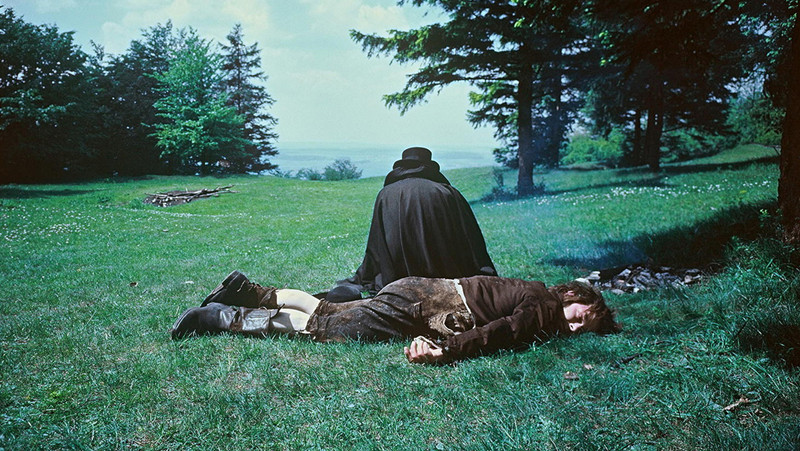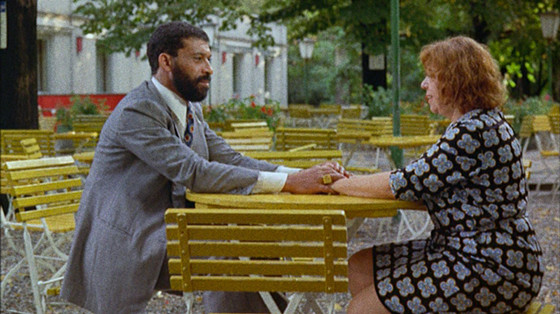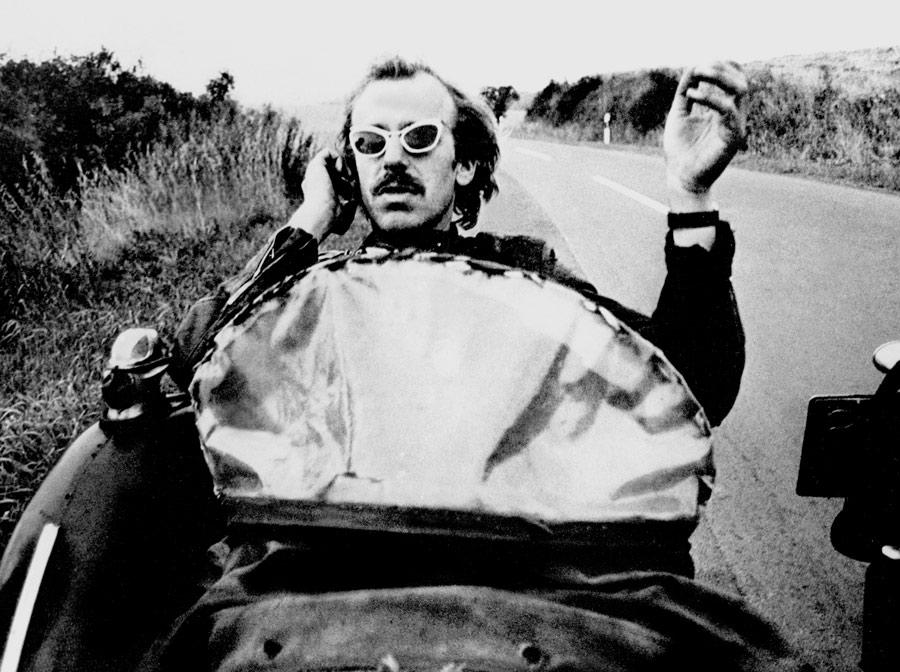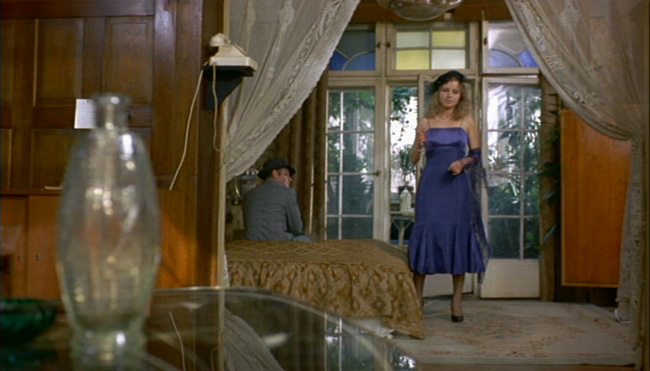6. The Enigma of Kaspar Hauser (Werner Herzog, 1974)
The Enigma of Kaspar Hauser is based on the true story of a boy who was kept in captivity for seventeen years by a man we suspect to be his father. His early days are briefly depicted in fragmentary form in the film’s opening scenes. Kaspar is kept chained in a barn with just a toy horse for company, and fed at regular intervals by a man in a dark overcoat and hat, who never speaks, except on the day he decides to release the teenage boy.
Kaspar is taught a few basic phrases, and also how to walk, before being left alone in the small town of Nuremberg. The people of the town initially don’t know what to do with Kaspar, since he can’t explain who he is or where he came from.
After a period of incarceration, and being exhibited in a freak show, Kaspar is adopted by a gentleman named Herr Daumer. Daumer patiently teaches Kaspar to read, write and play piano. Germans far and wide, including philosophers, clergy and nobility, take an interest in Kaspar, submitting him to interviews and tests.
Kaspar is played by street-musician Bruno Schleinstein, who would later play the lead role in Herzog’s Stroszek. Schleinstein was seen as the perfect person for the role, because of his similarly deprived childhood and unusual personality.
7. Ali: Fear Eats The Soul (Rainer Werner Fassbinder, 1974)
Ali: Fear Eats The Soul is a tender movie by Fassbinder’s standards. It tells the story Ali, a gastarbeiter (immigrant worker) in his late-thirties and the unusual relationship he forms with Emmi, a widow in her sixties. They meet in a dive-bar, into which Emmi has fled from the rain outside.
Ali is encouraged to ask Emmi to dance, and an unlikely tenderness between the two characters starts to form. Soon Ali has moved in with Emmi and they are married, but not without difficulty. Due to Ali’s ethnicity, and Emmi’s age, the reactions to their relationship from family and ‘friends’ are severe. Emmi’s children reject her. The women in Emmi’s building start talking behind her back, presumably jealous of Emmi’s.handsome young husband.
In fact, it gets to the point where it seems the entire town is against Emmi and Ali’s relationship. As with many of his films, Fassbinder took aim at the bigotry and small-mindedness that remained in Germany long after the fall of the Nazi regime.
Ali: Fear Eats The Soul is a more accessible film by Fassbinder’s standards because there is an evident warmth of feeling for Emmi and Ali. They are by no means perfect people, but the sense that they are taking on a whole society (indeed, a whole history) makes this Fassbinder’s most emotionally involving film.
8. Kings of The Road (Wim Wenders, 1976)
Wim Wenders pioneered the German road movie, and Kings of The Road is the classic of the genre. It is the third part of Wenders’ Road Movie trilogy, but Kings of The Road is the most typically road-movie-ish of the three (the other two being Alice in The Cities and The Wrong Move.)
Indeed, John Wakeman has called it “the ultimate road movie”. And leaving genre aside, Roger Ebert called it “one of the best movies of the 70s”. That said, this is a slow film, with long static shots of often barren scenery and open roads. And the protagonists don’t do all that much talking.
Viewers looking for something akin to Paris, Texas or Wings of Desire need to look elsewhere. But given its due patience, the film is as rewarding as any of Wenders’ more popular films.
It is a film of particular interest to cinephiles. One of the protagonists, Bruno Winter, drives from town to town repairing cinema projectors. Many scenes take place in projection rooms in dilapidated small-town cinemas. A sense of nostalgia and loss permeates these scenes: a recognition that cinemas aren’t what they used to be, and that the way films are consumed won’t stay the same forever.
9. The American Friend (Wim Wenders, 1977)
Wim Wenders’ The American Friend is based on Patricia Highsmith’s Ripley’s Game. Viewers familiar with other films based on Highsmith’s “Ripliad”, such as The Talented Mr. Ripley (Anthony Minghella), Plein Soleil (René Clément ) or Ripley’s Game (Liliana Cavani), may be a little surprised by how much different in tone this film is. Ripley is played by a stetson-wearing Dennis Hopper.
When Highsmith first saw the film, she thought Hopper was completely unsuited to the role, but then revised her opinion, saying Hopper had in fact captured the essence of Ripley. Since Ripley is known as a master impersonator, and in some sense an essence-less character (a cavalcade of masks), this is high praise from Highsmith indeed.
Ripley is living in Hamburg, Germany, where he’s involved in art forgery. Ripley gets a terminally ill picture-framer (Jonathan Zimmerman, played by Bruno Ganz) to assassinate a gangster in exchange for money he can leave for his family. While the relationship between the two characters is cold at first, a bond starts to form, and the film develops into that unique kind of buddy-movie that only Wenders can make.
Indeed, this is a film all about character and atmosphere, rather than plot. Wenders leaves a lot to the imagination, leaving out a raft of details from the novel. This makes it somewhat hard to follow, especially if you’re expecting a thriller, but the chemistry between the leads, and Wenders’ eye for the perfect shot, make it a captivating (if not “thrilling”) film.
10. The Marriage of Maria Braun (Rainer Werner Fassbinder, 1979)
The Marriage of Maria Braun begins in 1943 Germany, where Maria marries German soldier Hermann after their brief fling. After Hermann returns to the front, he is soon reported dead. Maria starts working in a bar, where she meets and starts a relationship with the African-American GI, Bill. One night, as they undress, Hermann—not in fact dead—walks in and in the ensuing chaos Bill is killed by Maria.
In an unexpected act of generosity, Hermann decides to take the blame for Bill’s death, and goes to jail for the crime. Maria’s third relationship is with Oswald, a wealthy industrialist who hires Maria as his assistant and quickly falls in love with her.
The Marriage of Maria Braun is the film of Fassbinder’s where the influence of Douglas Sirk and melodrama in general is most obvious. The plot is pure melodrama, but the execution is decidedly not. There is an uncanny blend here of old and new forms, but it is not empty pastiche—the characters are real, not cut from old stereotypes (we can see a similar use of melodrama in Todd Haynes’ more colorful Far From Heaven).
Fassbinder doesn’t disdain his lower-brow influences, instead he fluently incorporates them into his cinematic language, so that his films (and this film in particular) seem to embody cinematic history. Fassbinder’s film is in a sense an act of excavation: finding the truth of an era buried under old forms of expression.
Author Bio: Ciaran is originally from Dublin, Ireland, but currently lives in New York. He has passionate interest in European and Japanese cinema – the old stuff in particular. The directors who have left the deepest impression on him are Jacques Rivette, Eric Rohmer and Marco Ferreri.



